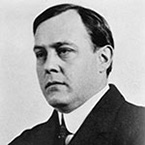
A pathologist best known to historians as the man who performed the autopsy on President William McKinley after his assassination in Buffalo, New York, Harvey R. Gaylord was also a sought-after speaker. He could expound on highly technical areas of cancer research, as well as on simpler areas of the disease that were of interest to the general public, and he did so with considerable charm and wit. As a graduate of the University of Pennsylvania Medical School (MD, 1893), he studied pathology with Professor Ludwig Aschoff in Germany and later went to Copenhagen to study Professor Carl O. Jensen’s techniques of inoculating tumors. In 1898, he joined Dr. Roswell Park at the New York State Laboratory for Cancer Research at the University of Buffalo Medical School, one of a few laboratories in the country devoted solely to cancer research.
At the close of the 19th century, it was only through the determined efforts of Dr. Park and the publisher of the Buffalo Evening News, Edward H. Butler Sr., that the New York State Institute for the Study of Malignant Disease was funded. Dr. Gaylord became the Institute’s pathologist and director of much of its research. He used the knowledge of immunology he had gained abroad to study animal cancers; the results of his research formed a part of the common knowledge of experimental cancer. Also on the staff were Drs. George H.A. Clowes, a chemist, and Leo Loeb, a pathologist; both would later join Dr. Gaylord and others in founding the AACR. Their work on cancer etiology and immunology and compounds for producing antitumor effects on transplantable tumors is recognized for its ground-breaking insights into cancer causes and treatment. Dr. Gaylord became the second director of the Institute, known today as Roswell Park Cancer Institute.
Dr. Gaylord had an unwavering belief in the power of education and collaboration in dealing with seemingly intractable problems. He was a prime organizer of the International Congress of Cancer in Paris in 1906 and collaborated with scientists throughout Europe. One collaboration led to installation of early x-ray technology at the Institute and a subsequent visit by Marie Curie. He also recruited Drs. Carl and Gerty Cori from Vienna to work at the Institute. Dr. Gaylord served as the first AACR Secretary from 1907 to 1909 and as AACR president in 1909 and in 1916. During his first presidential term, he wrote to President William H. Taft to facilitate the first federal funding for cancer research, and in his second term, the AACR launched the first English-language cancer journal (Journal of Cancer Research).